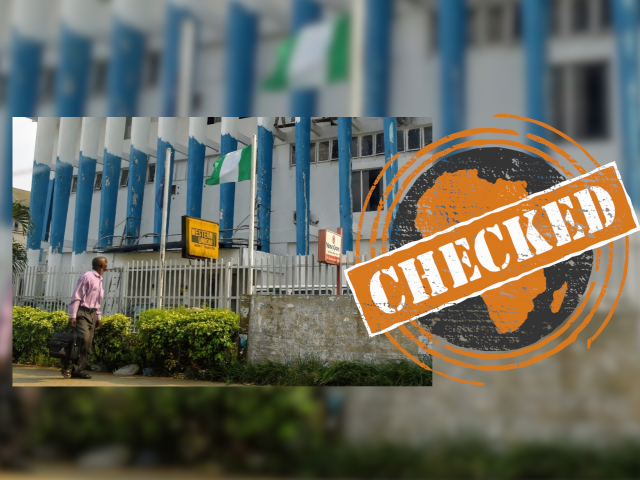Tẹ ibi lati ka ẹyà Yorùbá iroyin yii. Click here to read the Yoruba version of this report.
A video of three strange human-like babies with tails, big ears and dark stripes on pale blue skin has raised questions on a faith-based Facebook page in Nigeria.
A male voice speaking Yoruba is dubbed over the video.
His words can be translated as: “Holy is our God, the most powerful God. He is so powerful he created people and spirits and many animals in the heavenly places. It’s one of the animals he created that has birthed these triplets you are seeing. It’s one of the animals called the zebra, which is as large as a horse, that gave birth to these triplets. How can a zebra give birth to humans? What can’t God do?”
The post has been liked almost 790 times, and shared by more than 5,800 users.
Zebras are African horses, belonging to the equid family of hoofed mammals that includes regular horses and donkeys. They’re best known for their black and white stripes, and have a heavy head, stout body, stiff mane and tufted tail.
But did a zebra give birth to the three babies in the video? No.

A reverse image search for single images from the video led us to a story on the UK’s Daily Mail website.
The story shows the same video, and explains that the “babies” are just dolls. They were created as props for the 2009 movie, Avatar. The movie tells the story of the fictional Na'vi people, who have big ears, tails and dark stripes on blue skin.
The dolls were made of a rubbery material called silicone. The silicone makes them seem real, and lets the person’s hand in the video move their arms and tails.
The dolls were created by a company called BABYCLON. It specialises in creating life-size silicone baby sculptures. – Motunrayo Joel
Fidio abami kan ti n ja rain-rain lori ẹrọ ayelujara bayii. Awọn abami ọmọ-kekere jojolo mẹta la ri ninu fiimu ọhun. Kayeefi ibẹ ni pe; awọn mẹtẹẹta ni iru nla, wọn leti nla bẹẹ la ri i pe awọ buluuu, iyẹn awọ olomi aro, lo wa lara wọn. Awuyewuye si ti n lọ lori fiimu ọhun. Ijo-ẹlẹsin kan lo gbe fọnran naa sori ẹrọ ibaṣọrẹẹ alatagbaa, eyi ti a n pe ni facebook, wọn ni Naijiria.
Ohun kan la gbọ ninu fọran yii to n sọ wipe: “Mimọ ni Ọlọrun wa, Ọlọrun to lagbara julọ. O lagbara, O da eniyan, emi ati oriṣiiriṣii ẹranko ninu awọn ọrun.
“Ọkan lara awọn eranko ti Ọlọrun da lo bi ibẹta ti o ri yii. Kẹtẹ-kẹtẹ abila ni orukọ ẹranko naa, o tobi bii ẹṣin. O bi ibẹta. Bawo ni Kẹtẹ-kẹtẹ abila ṣe le bi ọmọ eniyan? Kin ni Ọlọrun ko le e ṣe?”
Awọn eeyan bii Ẹgbọrin-o-din-mẹwaa ni wọn ti lọwọ si fidio yii lori ẹrọ ayelujara facebook, bẹẹ lawọn eeyan to fẹẹ to Ẹgbẹrun mẹfa naa ti fi ranṣẹ kaakiri gbogbo agbaye.
Kẹtẹ-kẹtẹ abila jẹ ọkan ninu awọn ẹranko ti a maa n ri nilẹ adulawọ, Afrika. Inu ẹgbẹ kan naa loun atawọn ẹranko bii ẹṣin ati rakunmi wa, idi ni pe ẹsẹ awọn ẹranko yii fẹẹ ri bakan naa. Ṣugbọn iyatọ to wa laaarin kẹtẹ-kẹtẹ abila atawọn yooku ti wọn jọ jẹ ọmọ ẹgbẹ kan naa ni pe oriṣi awọ meji to ṣe e da mọ lo wa lara ẹ; awọ dudu ati funfun.
Bakan naa lori ẹranko yii maa n tobi, bẹẹ ni wọn si ṣe firigbọn. Irun to wa nibi ọrun titi de ibi agbari ẹranko yii naa tun yatọ si tawọn yooku ẹ, bẹẹ si ni iru wọn naa ri.
Ṣugbọn ohun to yẹ ka beere ni pe ṣe kẹtẹ-kẹtẹ abila lo bi awọn ọmọ kekere mẹtẹẹta taa ri ninu fọran yii ni? Rara o.
Iwadii taa ṣe lori fidio yii lo ṣe atọna wa si iroyin kan taa ri ka lori ẹrọ alatagbaa iwe iroyin ilẹ gẹẹsi kan ti wọn n pe ni Daily Mail.
Iroyin yii ṣafihan iru fidio taa sọrọ rẹ yii gan an, o ṣalaye pe ohun iṣere awọn ọmọde lasan lohun ti a ri, taa n pe lọmọ eniyan. Fiimu oyinbo kan ti wọn pe akọle ẹ ni Avatar ni wọn ṣe awọn ohun iṣere yii fun, ọdun 2009 ni wọn gbe fiimu Avatar yii jade.
Awọn ohun eelo ti wọn yọ lara rọba ni wọn fi ṣe ohun iṣere awọn ọmọde yii, kin ni kan ti wọn n pe ni silikọọnu, Silicone, lede oyinbo ni wọn fi ṣe e, kinni ọhun lo mu ki wọn (awọn ọmọ kekere taa n wo ninu fiimu) dabii ọmọ gidi, silikọọnu yii lo n mu wọn gbe'wọ; gbe'sẹ ati iru wọn, to fi da bii pe ṣẹranko-ṣeniyan ni wọn.
Ileeṣẹ kan ti wọn n pe ni BABYCLON lo ṣe ohun iṣere awọn ọmọde yii. Ohun ti ileeṣẹ yii mọ ọn ṣe ni lati maa ṣe awọn ohun iṣere ọmọde to da bii eeyan gidi. – Motunrayo Joel
Further reading:
https://africacheck.org/fbcheck/strange-creature-in-embu-actually-silicone-sculpture-by-italian-artist/
https://africacheck.org/fbcheck/weird-creature-in-muranga-kenya-no-another-silicone-sculpture-by-italian-artist-laira-maganuco/
https://africacheck.org/fbcheck/man-with-no-heart-needs-surgery-no-photos-of-us-actor-robert-downey-jr-in-iron-man/
A video of three strange human-like babies with tails, big ears and dark stripes on pale blue skin has raised questions on a faith-based Facebook page in Nigeria.
A male voice speaking Yoruba is dubbed over the video.
His words can be translated as: “Holy is our God, the most powerful God. He is so powerful he created people and spirits and many animals in the heavenly places. It’s one of the animals he created that has birthed these triplets you are seeing. It’s one of the animals called the zebra, which is as large as a horse, that gave birth to these triplets. How can a zebra give birth to humans? What can’t God do?”
The post has been liked almost 790 times, and shared by more than 5,800 users.
Zebras are African horses, belonging to the equid family of hoofed mammals that includes regular horses and donkeys. They’re best known for their black and white stripes, and have a heavy head, stout body, stiff mane and tufted tail.
But did a zebra give birth to the three babies in the video? No.

Na’vi ‘babies’ made from lifelike silicone
A reverse image search for single images from the video led us to a story on the UK’s Daily Mail website.
The story shows the same video, and explains that the “babies” are just dolls. They were created as props for the 2009 movie, Avatar. The movie tells the story of the fictional Na'vi people, who have big ears, tails and dark stripes on blue skin.
The dolls were made of a rubbery material called silicone. The silicone makes them seem real, and lets the person’s hand in the video move their arms and tails.
The dolls were created by a company called BABYCLON. It specialises in creating life-size silicone baby sculptures. – Motunrayo Joel
Awọn ọmọ ẹranko n fọhun bii eeyan? Rara o
Fidio abami kan ti n ja rain-rain lori ẹrọ ayelujara bayii. Awọn abami ọmọ-kekere jojolo mẹta la ri ninu fiimu ọhun. Kayeefi ibẹ ni pe; awọn mẹtẹẹta ni iru nla, wọn leti nla bẹẹ la ri i pe awọ buluuu, iyẹn awọ olomi aro, lo wa lara wọn. Awuyewuye si ti n lọ lori fiimu ọhun. Ijo-ẹlẹsin kan lo gbe fọnran naa sori ẹrọ ibaṣọrẹẹ alatagbaa, eyi ti a n pe ni facebook, wọn ni Naijiria.
Ohun kan la gbọ ninu fọran yii to n sọ wipe: “Mimọ ni Ọlọrun wa, Ọlọrun to lagbara julọ. O lagbara, O da eniyan, emi ati oriṣiiriṣii ẹranko ninu awọn ọrun.
“Ọkan lara awọn eranko ti Ọlọrun da lo bi ibẹta ti o ri yii. Kẹtẹ-kẹtẹ abila ni orukọ ẹranko naa, o tobi bii ẹṣin. O bi ibẹta. Bawo ni Kẹtẹ-kẹtẹ abila ṣe le bi ọmọ eniyan? Kin ni Ọlọrun ko le e ṣe?”
Awọn eeyan bii Ẹgbọrin-o-din-mẹwaa ni wọn ti lọwọ si fidio yii lori ẹrọ ayelujara facebook, bẹẹ lawọn eeyan to fẹẹ to Ẹgbẹrun mẹfa naa ti fi ranṣẹ kaakiri gbogbo agbaye.
Kẹtẹ-kẹtẹ abila jẹ ọkan ninu awọn ẹranko ti a maa n ri nilẹ adulawọ, Afrika. Inu ẹgbẹ kan naa loun atawọn ẹranko bii ẹṣin ati rakunmi wa, idi ni pe ẹsẹ awọn ẹranko yii fẹẹ ri bakan naa. Ṣugbọn iyatọ to wa laaarin kẹtẹ-kẹtẹ abila atawọn yooku ti wọn jọ jẹ ọmọ ẹgbẹ kan naa ni pe oriṣi awọ meji to ṣe e da mọ lo wa lara ẹ; awọ dudu ati funfun.
Bakan naa lori ẹranko yii maa n tobi, bẹẹ ni wọn si ṣe firigbọn. Irun to wa nibi ọrun titi de ibi agbari ẹranko yii naa tun yatọ si tawọn yooku ẹ, bẹẹ si ni iru wọn naa ri.
Ṣugbọn ohun to yẹ ka beere ni pe ṣe kẹtẹ-kẹtẹ abila lo bi awọn ọmọ kekere mẹtẹẹta taa ri ninu fọran yii ni? Rara o.
Awọn ohun iṣere ọmọde to n fọhun bii eeyan
Iwadii taa ṣe lori fidio yii lo ṣe atọna wa si iroyin kan taa ri ka lori ẹrọ alatagbaa iwe iroyin ilẹ gẹẹsi kan ti wọn n pe ni Daily Mail.
Iroyin yii ṣafihan iru fidio taa sọrọ rẹ yii gan an, o ṣalaye pe ohun iṣere awọn ọmọde lasan lohun ti a ri, taa n pe lọmọ eniyan. Fiimu oyinbo kan ti wọn pe akọle ẹ ni Avatar ni wọn ṣe awọn ohun iṣere yii fun, ọdun 2009 ni wọn gbe fiimu Avatar yii jade.
Awọn ohun eelo ti wọn yọ lara rọba ni wọn fi ṣe ohun iṣere awọn ọmọde yii, kin ni kan ti wọn n pe ni silikọọnu, Silicone, lede oyinbo ni wọn fi ṣe e, kinni ọhun lo mu ki wọn (awọn ọmọ kekere taa n wo ninu fiimu) dabii ọmọ gidi, silikọọnu yii lo n mu wọn gbe'wọ; gbe'sẹ ati iru wọn, to fi da bii pe ṣẹranko-ṣeniyan ni wọn.
Ileeṣẹ kan ti wọn n pe ni BABYCLON lo ṣe ohun iṣere awọn ọmọde yii. Ohun ti ileeṣẹ yii mọ ọn ṣe ni lati maa ṣe awọn ohun iṣere ọmọde to da bii eeyan gidi. – Motunrayo Joel
Further reading:
https://africacheck.org/fbcheck/strange-creature-in-embu-actually-silicone-sculpture-by-italian-artist/
https://africacheck.org/fbcheck/weird-creature-in-muranga-kenya-no-another-silicone-sculpture-by-italian-artist-laira-maganuco/
https://africacheck.org/fbcheck/man-with-no-heart-needs-surgery-no-photos-of-us-actor-robert-downey-jr-in-iron-man/
Republish our content for free
For publishers: what to do if your post is rated false
A fact-checker has rated your Facebook or Instagram post as “false”, “altered”, “partly false” or “missing context”. This could have serious consequences. What do you do?
Click on our guide for the steps you should follow.
Publishers guideAfrica Check teams up with Facebook
Africa Check is a partner in Meta's third-party fact-checking programme to help stop the spread of false information on social media.
The content we rate as “false” will be downgraded on Facebook and Instagram. This means fewer people will see it.
You can also help identify false information on Facebook. This guide explains how.





Add new comment